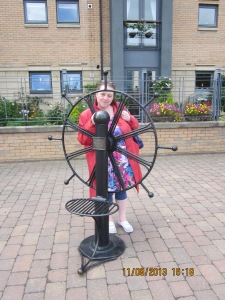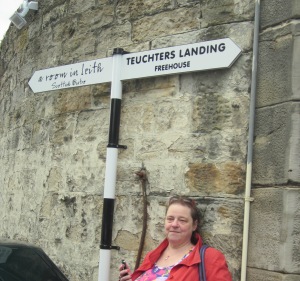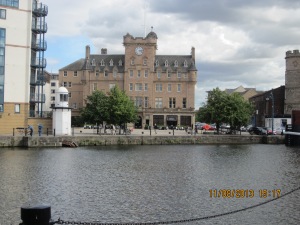I was born in Leith, on the Eastern boundary at the Eastern General Hospital, now a care home for the elderly. I was educated in Leith; primary in South Leith and secondary in North Leith. I have always worn my heritage with pride. When I discover that a person knows Edinburgh, I make the distinction – I am from Leith.
The only family connection to Leith was my mother’s father, who I never met; he was born and brought up here. My parents came to live here after they married and remained in South Leith for the rest of their married lives, both now at rest in Seafield – Leith’s cemetery.
The port has a long history, the best natural harbour on the East coast of Scotland; it was a hub of trading and seafaring activities with the Baltic and Scandinavia, having no rival between the River Tay to the North and the River Tweed to the south. It was a member of the Hanseatic League; a fact I only learnt recently. It is always good to learn something new about a place you thought you knew a lot about.
 A steering wheel converted into a seat, and decorating the Shore
A steering wheel converted into a seat, and decorating the Shore
It has always had a difficult relationship with the capital, mirroring in some way Scotland’s relationship with England, what ever is said, they were never equal partnerships. If goods were landed at Leith, they were received and valued by officials from Edinburgh, to be sold at the Mercat Cross in the city. Freemasons of the burgh had first refusal. This practice gives it name to Burgess Street in Leith, where they used to stay to undertake these tasks. Nearby Parliament St was where Mary of Guise ruled the country, acting as regent for her daughter Mary Queen of Scots. Leith did however, vote to stay independent from the city in a referendum in 1929, the decision was ignored.
In the eighties the port declined due to its size, the docks were too small for modern commercial shipping and it fell into disuse, exacerbated by occurring during the Thatcher years. The port became an entry point for drugs, mainly heroin, which is brought to light in the iconic novel “Trainspotting” by Irvine Welsh. I read it; I didn’t like it because it talked about a place that was alien to my personal experience. The title comes from the fact that the junkies used to hang out in the disused Leith Train station and Trainspotting was their name for going there to get a high. I did feel that Welsh, a fellow Leither, portrayed the real and awful nature of addiction and drug abuse but it could have been set in any urban city with a drug problem in the Western World, written in the local argot of the location chosen. There were more references to other parts of the city than in Leith itself – I counted as I read.
Why would I bother doing this? Because I had become fed up of the reaction to people who knew nothing about the city saying “oh years ago you wouldn’t admit to being from Leith.” An attitude normally based on the notoriety of the novel. In my case and that of most fellow Leithers I know that is not true.
Fortunately, the port has undergone regeneration, the Shore, which is the area leading to the docks, is located on the banks of the Water of Leith. The tributary of the Forth that meanders its way through the city; it used to power the windmills.
 Some of the original dock wall, now signposting popular eateries.
Some of the original dock wall, now signposting popular eateries.
Is now home to many eateries that cater for all tastes and budgets – from Michelin star to bargain diner. One of the best pubs is the Kings Wark, this is where Mary Queen of Scots lodged on her return from France, after being widowed for the first time. It is also where GeorgeIV landed in 1822 marking the first official Royal visit to Scotland over 200 years after the union of the Crowns.
I remember when I saw the regenerated Shore area for the first time; it had been run down and dismal for as long as I could remember. I was on the bus travelling to see the Ocean Terminal shopping centre, current home of Royal Yacht Britannia when the bus passed though the cross roads at Sandport street. The seediness had gone, new build melded with old, the medieval character had been brought out.
 The former sailors rest now the Mal Maison hotel, new apartment blocks and the lighthouse.
The former sailors rest now the Mal Maison hotel, new apartment blocks and the lighthouse.
Ever since I returned home in 2008, I enjoy the trip as I love the feeling as the bus leaves the street behind, the cityscape snaps open as the road meets the river on its left.

Very well written!
A very Interesting read that has brought Leith back alive to me 🙂
As a fellow Leither I found this very interesting